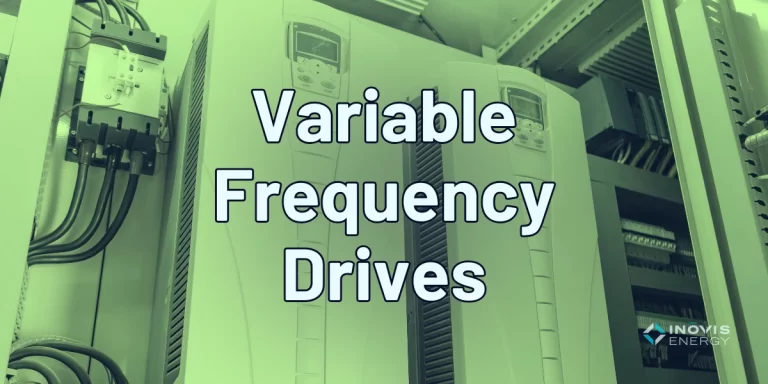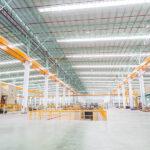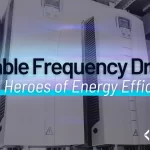Variable Frequency Drives (VFD) for Efficient HVAC Motor Control
Home » Solutions » HVAC Upgrades » Variable Frequency Drives (VFD)
Variable Frequency Drives (VFDs) improve HVAC system efficiency by controlling motor speed based on real-time demand. These devices can be added to pumps, fans, and air handlers to reduce energy waste and extend equipment life.
Table of Contents

What Are Variable Frequency Drives?
A Variable Frequency Drive (VFD) is a device that adjusts the speed of an electric motor to match the system’s actual load. Rather than running motors at full speed all the time, VFDs allow for dynamic control—delivering only the airflow or water flow needed at any given moment.
VFDs are commonly installed on:
-
HVAC supply and return fans
-
Chilled water or hot water pumps
-
Cooling towers
-
Air handling units (AHUs)
By reducing unnecessary motor runtime, VFDs can lower energy use by 20–50% in properly sized applications. They also reduce mechanical stress and noise, contributing to longer equipment life and improved occupant comfort.
Advantages of Installing Variable Frequency Drives
Key Benefits:
-
Reduce motor energy use by up to 50%
-
Lower utility bills and peak demand charges
-
Extend the life of motors, fans, and pumps
-
Improve occupant comfort with smoother operation
-
Qualify for utility rebates and efficiency programs
-
Enable better control of system performance
-
Reduce wear-and-tear caused by frequent start/stop cycles
How Do VFDs Work in HVAC Systems?
Variable Frequency Drives, or VFDs, control the speed and torque of an electric motor by varying the input frequency and voltage. This process begins with the VFD’s converter, which changes the incoming AC power to DC power. The DC power is then filtered through a DC bus.
This leads us to the second major part of a VFD: the inverter. This inverter uses pulse width modulation to simulate a sine wave that can be utilized by the motor. The speed of the motor shaft rotation – and hence the motor speed – can then be precisely controlled by varying the frequency of this simulated sine wave.
VFDs also utilize a control system to monitor and adjust the speed and torque of the motor based on the load requirements of the system. This control system uses feedback from the motor to tune the output of the VFD to match the required load of the system.
By precisely controlling motor speed and torque, VFDs can significantly increase system efficiency, reduce energy costs, and extend the life of the motor.
Industries That Benefit from VFDs
Related Facilities
Variable Frequency Drives (VFDs) are versatile and can provide significant energy savings across a broad spectrum of facilities. Some of the key types of facilities that can leverage VFDs include:
- Industrial Facilities: Manufacturing plants, factories, and warehouses can realize significant cost savings by installing VFDs. Install them on motor-driven equipment such as conveyors, crushers, and pumps.
- Commercial Buildings: Office buildings, shopping malls, and hotels can apply VFDs on HVAC system fans and pumps, elevators, and escalators for efficient operation.
- Healthcare Facilities: Hospitals, laboratories, and clinics can benefit from VFDs on critical applications like air handling and pressurization.
- Educational Institutions: Schools, colleges, and universities can use VFDs on HVAC systems and other motor-driven equipment.
- Municipalities: Water treatment plants, pumping stations, and other municipal facilities can leverage VFDs to optimize pump and fan performance.
How We Implement VFD Upgrades
-
Site Evaluation – Identify motor-driven HVAC systems suited for VFD retrofits
-
Load Analysis – Review operating conditions to determine energy-saving potential
-
Incentive Mapping – Check for utility rebate eligibility and pre-approval requirements
-
VFD Sizing & Selection – Match equipment to motor specs and building controls
-
Installation & Commissioning – Install the drive, wire controls, and verify system integration
-
Post-Install Support – Provide training and ensure systems operate to spec
Rebates and Incentives for VFD Projects
VFD installations often qualify for:
-
Prescriptive utility rebates per HP or kW controlled
-
Custom efficiency incentives based on savings projections
-
Bundled energy upgrade funding alongside lighting, BAS, or HVAC upgrades
-
On-bill financing or performance-based service agreements
We help clients secure rebates and provide cost-benefit analysis to support budget planning.
Looking for a VFD Installer?
Variable Frequency Drives are a simple, proven way to reduce HVAC energy use and improve system performance. Let’s evaluate your motors and identify the best opportunities for savings.









